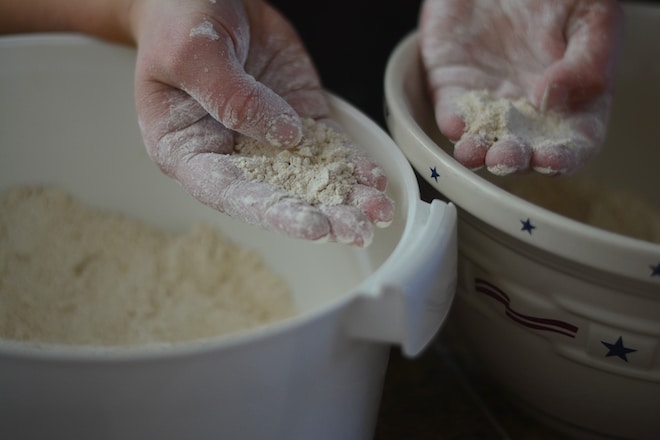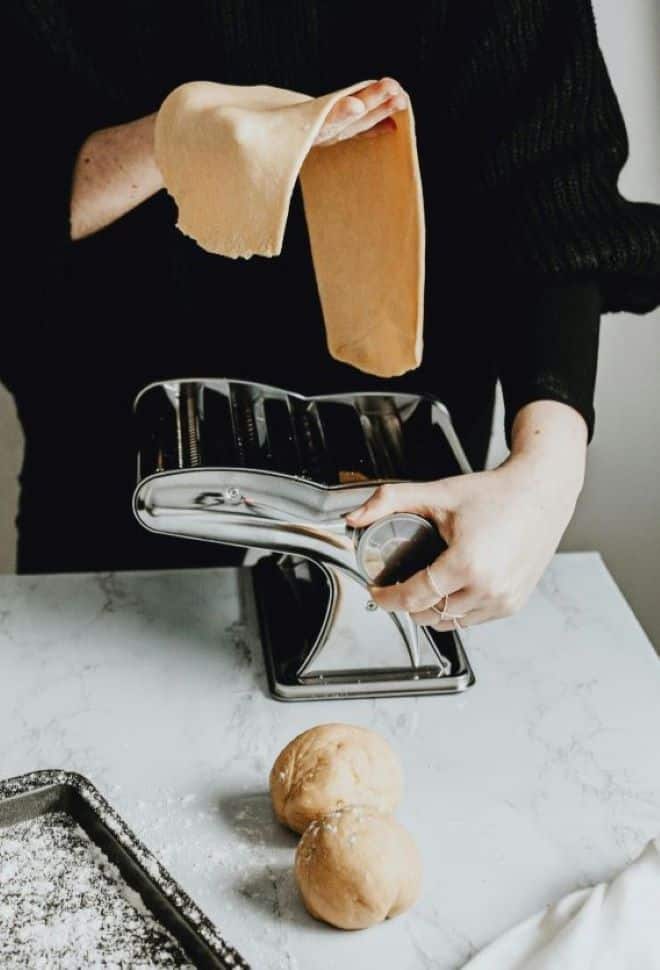Last Updated on September 8, 2025 by Michelle
When I first started out on my real-food journey, I never thought I’d make lasagna noodles from scratch.
It seemed like the end-all-be-all of homemade products.
I continued making lasagna for years with boxed noodles, thinking to myself one day soon I’ll learn how to make lasagna noodles from scratch! But in the back of my mind, I assumed it would never really happen, because who has time for that?
Turns out, making lasagna noodles from scratch is actually, like, Super Easy. With a capital “S.” No idea why I let this intimidate me.

Then, when I started converting my kitchen over to fresh milled flour, I went through the same process again. I had figured out how to make homemade lasagna noodles with dead store flour, but surely making them with fresh flour would be difficult. Again, I let it slide and continued making lasagna noodles with store bought flour (or buying them), even as I conquered chewy cookies, fluffy rolls, and even sourdough bread, all made with fresh, whole wheat flour.
Then, one day, I thought no more of this and I just did it. I made lasagna noodles from scratch with fresh milled flour. And you know what? It’s easy. I haven’t looked back.
So let’s make lasagna noodles with fresh flour.

How to Make Lasagna Noodles from Scratch
To make lasagna noodles from scratch you only need three ingredients that you most likely have sitting around your house; flour, salt, and eggs. It’s as simple as that!
Do You Have to Boil Fresh Pasta for Lasagna?
Ah, the age old question. The short answer is it depends. I choose to boil my noodles for a few minutes before assembling my lasagna because I find that it just makes a better end result. I’ve definitely made lasagna noodles with fresh flour and NOT boiled them before assembling, but I find the results are more consistent and you wind up with a better texture in the end if you stick the noodles in boiling water for a minute. Try it both ways, though, and see which way works best for you.
Should You Use Fresh of Dried Pasta Sheets for Lasagna?
Until just recently I always used dried pasta sheets for lasagna, which is fine, but using fresh pasta, made with fresh milled flour, is much tastier and definitely offers more nutrients. Of course, you can have the best of both worlds, so to speak, and dehydrate your fresh lasagna noodles as well.
Can I Assemble Lasagna with Fresh Pasta Ahead of Time?
Absolutely, you can make your lasagna days ahead, with noodles made from fresh flour, and store it in the fridge (or freezer) until you’re ready to enjoy.
What is the Best Flour for Making Lasagna Noodles?
Officially, durum is the pasta-making grain. However, I found that using just durum in my pasta doughs resulted in a slightly grainy texture, so I settled on a mixture of durum, hard white, and soft white for a chewy, yet smooth pasta. Feel free to play around with what grains work best for your pastas, but the ratio I’ve settled on is roughly 50% durum, 25% hard white, and 25% soft white.
How to Cook Lasagna Noodles so They Don’t Stick Together
Like we already covered, boiling your fresh lasagna noodles or not is up to you. However, if you choose to boil them, here are a few tricks to keep them from sticking together in the water.
- Make sure the texture of your pasta dough is correct. If you’re having a huge issue with the noodles sticking in the water, it could be that your dough was too sticky to start with. Next time, try adding more flour into your dough to make it stiffer.
- Use a big pot. Overcrowding the noodles is a surefire way to end up with a noodle mass.
- Bring your water to a rapid boil before you add the noodles. I’ve found that if my water is just lukewarm or not boiling rapidly, my noodles are much more likely to stick together.
What you need to make lasagna noodles
235 grams fresh milled flour (I use durum, hard white, and soft white in a 2:1:1 ratio)
3 large eggs
Generous pinch of salt
What to do when you make lasagna noodles
Mill your flour on a fine setting. Add the salt to the flour and mix slightly, then add the eggs and whisk them into the flour until a shaggy dough is created. Using your hands, knead the dough until there are to dry bits left. Continue to knead the dough for a few minutes until it’s smooth and stretchy, but still stiff. If the dough is too sticky, add more flour to make it more stiff, but still pliable.
Cover and let the dough rest for at least 30 minutes or up to 1 hour.
Using a pasta machine or a rolling pin, roll the dough out to your desired thickness. I usually do this with my pasta machine and start the dough on the thickest setting, then working my way down to a lower setting until it’s as thin as I want it. Don’t be afraid to sprinkle the dough with some flour if it’s sticking.
Boil the noodles after they’re cut or shaped how you’d like. (I often just keep the width of the noodles however they come out, and cut the length that will fit in my pan. It’s rustic, but it works really well.) Do keep in mind that fresh noodles only take about 2-3 minutes to cook fully, especially if your water is at a rolling boil.
Assemble your lasagna as desired and bake.
Enjoy!
[mv_create key=”2″ thumbnail=”https://soulyrested.com/wp-content/uploads/2021/12/DSC_0052.jpg” title=”Lasagna Noodles with Fresh Flour” type=”recipe”]
Talk to me about your lasagna noodles.
If you have any questions, leave a comment below. And please tag me on ig to show me your lasagna noodles @souly.rested.
Need a Grain Mill?
There are many options for grain mills.
These are the 3 I recommend:
-
- The Classic Nutrimill does a great job, at the lowest price point.
- The Harvest Mill wins for most beautiful to sit on your counter.
- And the Mockmill is a beautiful workhorse that wins for best engineered, best at milling alternative grains, and finest flour, but it also sits at the highest price point.
P.s. If you’re interested in a Nutrimill, code “SOULYRESTED” will save you cash!
More about just some of the alternative flours I make in the Mockmill here.
More recipes if you like making lasagna noodles
- Fluffy 100% fresh milled, whole wheat flour dinner rolls
- Why I started milling my own flour (and why I’ll never go back!)
- Sourdough bread made with fresh milled flour
- Kamut chocolate chip cookies
And be sure to Download my FREE Pantry Checklist and all the discounts on the best ingredients
“Whether you eat or drink, or whatever you do, do it all for the glory of God.” 1 Cor. 10:31
Pin this for later!
Click on the image below to pin this post.


I just watched the YT videos and can’t wait to do this.
Thanks for pointing out there are videos to assist with learning these new skills as I am a visual learner 🙂
I have to try this. Looks simple enough.
This is such a a great article! I can’t wait to make freshly milled flour and my own pasta with it! ♥️
👀 at the egg
Good intentions do not yield success for me. Milling fresh flour has been on my radar for over a year. You have inspired me to turn my interest into a reality. Thank you!